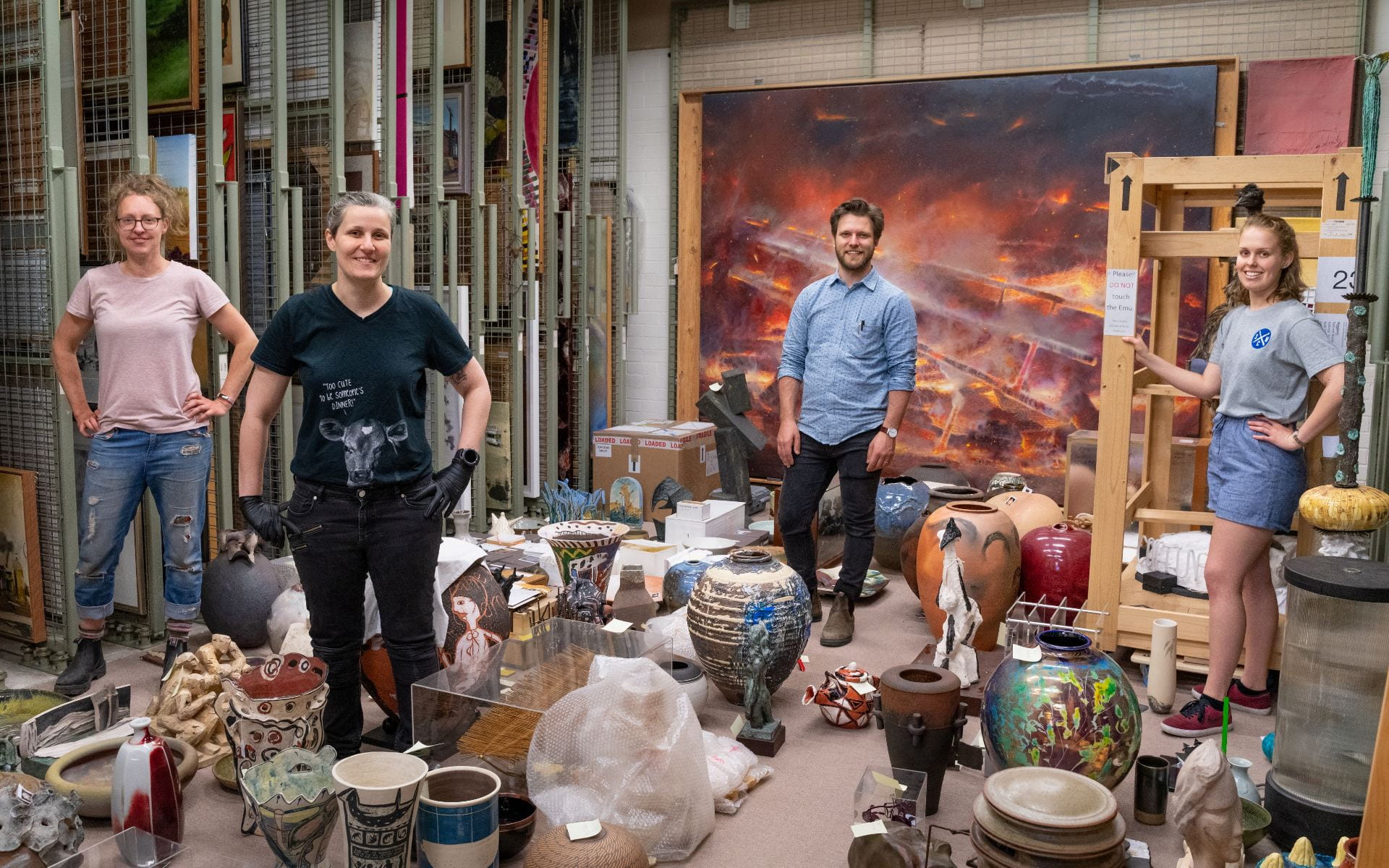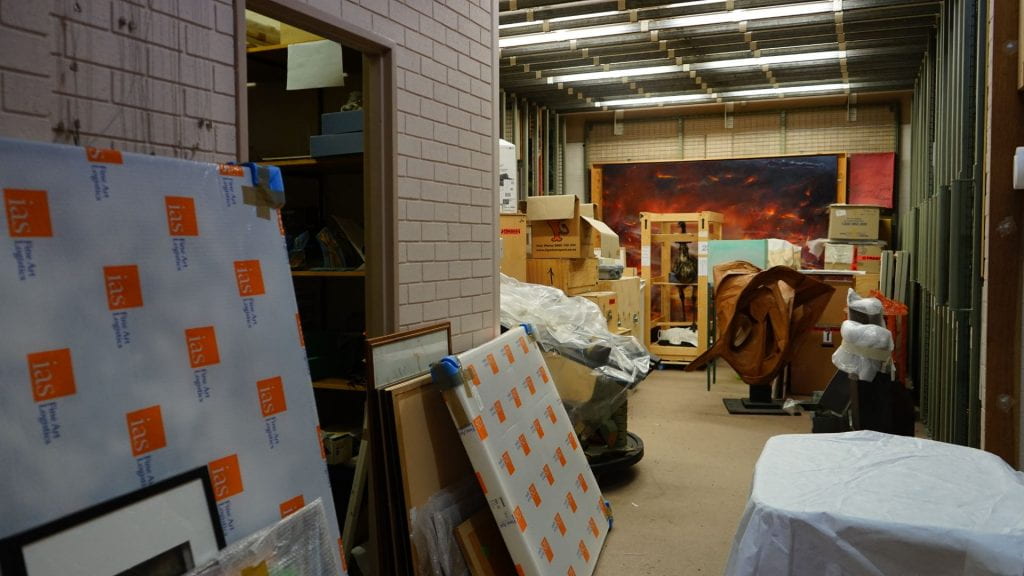
Partnering with Regional Museums and Galleries: Grimwade Graduates in Bathurst
Graduate students from the Grimwade Centre for Cultural Materials Conservation and Master of Curatorial Studies at University of Melbourne have been helping the Bathurst Regional Art Gallery (BRAG) to do the difficult but crucial work involved in reorganising their collection. Ashley Hayes describes the work the Centre is doing at BRAG and spoke with one of the team members, Master of Cultural Materials Conservation student Daniel Schwartz.
As students about to finish our degrees and embark into the professional world, we are often overcome with terrifying thoughts. Do I have enough experience in my field? How can I show that I am employable? These fears are something I’m sure many students in different disciplines can relate to.
The desire to work on an interesting, relevant, and hands-on project is something that inspired Master of Cultural Materials Conservation student Daniel Schwartz to facilitate the RE-ORG project in Bathurst, New South Wales. Think of RE-ORG as the Marie Kondo of museum organisation; however, everything in the BRAG collection sparks joy, it just needs to be organised and accessible.
The Grimwade Centre has a long history of collaboration with various institutions in Bathurst. Centre Director, Professor Robyn Sloggett has been instrumental in establishing many of these partnerships. After receiving the Bathurst Macquarie Heritage Medal, which recognises an individual who demonstrates a significant contribution to the protection or promotion of Australia’s built, social, cultural or environmental heritage, she created the Willem Snook Conservation Award, which promotes individual projects undertaken by students in the conservation program. Daniel Schwartz’s proposal to conduct a reorganisation of a museum’s storage facility in Bathurst was selected to receive this funding. Being able to funnel the money back into the community at Bathurst was an important consideration, as the Grimwade Centre encourages students to think outside of the big cities and create projects that benefit outer-urban, rural and remote communities.
The organisation of collections within museums and galleries is not a simple, straightforward task. We all have that one chair in our bedrooms that accumulates an intimidatingly large pile of clothes if we don’t set ourselves a schedule to put things away (or is it just me?) Similarly, if there’s no cleaning or organisation schedule in place, museum storage facilities can quickly become messy and potentially dangerous to the safety of the objects. What goes on behind the scenes within museum or gallery storage space is an ongoing process involving new acquisitions entering the space, objects being removed for exhibitions, and items being moved and rearranged to accommodate these changes. Without implementing a clearly defined system of organisation this process can put the collection at risk of dissociation, damage or loss (Waller & Cato 2019; Marcon 2018).
The RE-ORG program was established in 2010 as a result of a three-year research project conducted by UNESCO and the International Centre for the Study of the Preservation and Restoration of Cultural Property (ICCROM) which sought to create educational tools for the ‘Preventive Conservation of Endangered Museum Collections in Developing Countries’.
In 2011 ICCROM and UNESCO conducted a joint international survey of 1490 cultural institutions in 136 countries. The results of the survey were alarming: one in four museums had incomplete documentation systems; 2 in 3 museums had a lack of storage space to house their collection; one in three museums did not have clearly assigned staffing responsibilities for storage management; one in four museums had no accession register; and half of the respondents complained of overcrowding and/or a lack of storage units.
The methodology outlined within the RE-ORG program involves a structured approach to reorganising a collection. All of the tools necessary for this process are free and easily available online. The content supplied includes:
- A self-evaluation tool, which highlights the key risks that may be associated with collection storage
- A workbook with clear step-by-step instructions that are universally applicable to most institutions
- Worksheets which provide all of the necessary information the organisation needs to prepare for the reorganisation process
- Additional resources, for more detailed information for complex and specific issues.
These resources were accessed by Daniel Schwartz and the team conducting the RE-ORG project in Bathurst. Following the RE-ORG methodology they were able to successfully assist the Bathurst Regional Art Gallery (BRAG) in reorganising their collection. This helped to minimise the risk of damage and dissociation to their collection and reduced the work hours required to locate and access items within the collection for exhibition changeovers. I spoke to Daniel about his experience working in Bathurst.
Can you talk about the relationship that exists between Bathurst and the Grimwade Centre?
There have been a number of Grimwade students visiting Bathurst over the past few years to work on a range of projects with the different institutions and [the RE-ORG project] was another opportunity to maintain that relationship. Bathurst in particular is such a focus for the Grimwade Centre in developing a relationship because the faculty here are really keen to expand the access to cultural materials conservation to ex-urban, rural, remote, and regional communities. They have identified over the last several years that access to conservation is very localised in the major urban centres, and it’s a big part of our professional ethics [to include these communities], as well as to create job opportunities for students to establish those resources in these outer-city locations.

Following the methodology created by ICCROM-UNESCO and the Canadian Conservation Institute global initiative, you established a plan to reorganise the collection at BRAG. Can you talk about what was involved in this process?
Initially it involved a very cursory, superficial, visual investigation of the collections. We looked at the Art Gallery collection, the Motor Museum collection, and the ‘Stones and Bones’ palaeontology and natural history collection. BRAG stood out as the one that had the most achievable work.
The overcrowding of the storage facility was the big thing we wanted to handle. It was taking the staff at BRAG a whole day to access the collection. To identify, locate and obtain the items they wanted out of storage for exhibition changeovers required a lot of work hours for the staff. As we learn in conservation, the more time you engage with an object, the more it is put at risk [of being damaged and dissociated], which was a major concern for us.
We then worked from the outside in: from the external environment of Bathurst, to the location of the site, the construction details of the facility, looking at the space that surrounds the storage area, then the storage area itself, and then deeper into how individual objects are stored.
A lot of people in the field of conservation – and we’re growing out of this – but we tend to be object and material focused. We look at the object and then we expand outwards. I think it’s a lot more useful to think of preventive methods, to think outward in.

Was this something you took and applied from the RE-ORG methodology?
Yes, and this is something that’s taught in our [Master’s course] preventive conservation education program. In collaboration with Tim Pike, the collection manager at BRAG, we performed a self-evaluation [as outlined in the RE-ORG methodology]. [This involves] looking at the management and administration of the collection, the actual space the collection is housed in, which includes looking at the building plans. They look at the collection itself, and then the furniture and small equipment that builds up the storage facility.
After assessing all of those elements you are left with a score, which grades the urgency for a RE-ORG. BRAG fell within the bracket of ‘You need a RE-ORG project’ and ‘only small improvements necessary’. What we deemed as being necessary improvements was quite achievable in the time that we had allocated for this project, which is why BRAG was selected.
We identified two major issues at BRAG. Number one, there was overcrowding in the storage facility. We wanted to clear a space so that new items could come in, and so we could reduce the time that it takes to access items within the collection. One of the cool things within the methodology is that they have you play a game with the collection manager: you sit in front of their database and call out an item number and see how long it takes to retrieve it.
The second major issue identified during the RE-ORG at BRAG was the risk of dissociation, as many objects did not have identifiable information associated with them, such as accession numbers or photographs. Of the 2400 items in the collection, there were 975 objects without accession numbers, and 400 without photographs, and approximately 50 per cent of the objects did not have recorded dimensions. It was also unclear whether all items were free of active deterioration. These issues were rectified when Daniel and the team of student volunteers, Kate Ritchie and Elizabeth Gralton, from the Grimwade Centre, and Lisa Jacomos, doing a Masters of Curatorial Studies, went along to Bathurst in November 2018 to complete the RE-ORG project.

How did you hear about RE-ORG?
I heard about RE-ORG in 2012, in an undergraduate conservation course. Then in 2017 I attended a conservation workshop in Belgium, where one of the RE-ORG national partners came and spoke to us about the project. I thought it was a very democratic way to address the needs of collections in institutions all over the world, especially institutions and community centres that don’t have large budgets. Creating these very pared-down, self-directed projects that don’t require a large amount of funding is incredible. RE-ORG allows for free access to the methodology; it was created to be used by everyone.
Are there any future plans for more RE-ORG projects in Australia?
We were so pleased with the success of RE-ORG Bathurst, that we wanted to create a long-term initiative at the Grimwade Centre in conjunction with the National Conservation Program and the Student Conservators at Melbourne Uni (SC@M). We aim to have four to five funded and resourced projects a year, at urban and regional institutions, and in Indigenous communities.
We’re hoping to set up an open call for expressions of interest from institutions who would like to talk [to us] about their projects. By creating different projects at different levels we can provide access to a range of conservation resources.
It would be great to establish the Grimwade Centre as the National RE-ORG partner in Australia, as this was the first RE-ORG project to be carried out in Australia.
To read more about RE-ORG, visit the RE-ORG website and their page on preventive conservation.